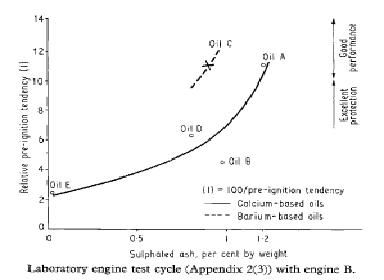Disclaimer: I'm still refining this list and doing research as best I can to give the most accurate representation of the data I can. Please check this post often (or at least until the disclaimer disappears as I'm constantly refining the oils listed).
Ash content is usually caused by impurities in the base oil. Which I believe is caused by Calcium being the biggest indicator. Looking solely at that these are the oils that contain calcium in <500 ppm.
Castrol 0w-30
Cenex AGME 4EP
Cenex AGME 7EP
Cenex Indol ISO 68
Cenex ISO 46
Cenex Mercon/Dexcon ATF
Cenex Turbine XL ISO 100
Cenex Turbine XL ISO 320
Chevron 80w-90
Exxon 60wt
Exxon 60wt
Hyde Dexron
Royal Purple 75w-90
Shell Omala 320
Unspec Unspec
Now you'll notice that a lot of the previously mentioned oils are not really suitable for use in an engine (gear oil, increased wear with ATF/dexron belnds, etc). So getting rid of those what we have left is:
Castrol 0w-30
Cenex Indol ISO 68(Really light oil it looks like)
Cenex ISO 46 (Really light oil it looks like)
Unspec Unspec (4/26/05)
Cenex Turbine XL ISO 100 (may be too thick for use; viscosity rating is the same as a 20w oil)
Turbine XL ISO 320 (may be too thick for use;viscosity rating is the same as a 20w oil)
Now looking at the additive package: High in zinc, low to medium in phosphorus, we have the following arranged low to high by such [Phosphorus|Zinc]
Unspec Unspec (4/26/05) [2|38]
Castrol 0w-30 [284|2]
Cenex Indol ISO 68 [383|517]
Cenex ISO 46 [963|1163]
Conclusion: Although a majority of the Oils listed can be used in a rotary engine, I would suggest using Cenex Indol ISO 68 based on the information I could see from the CAT VOAs. This is basing it off the findings of the NSU/SAE papers previously referenced. If the PPM on the Phosphorus is not high enough for your tastes Cenex ISO 46 will work slightly better. Please be aware though that the higher the Phosphorus the more likely foaming will occur. Please take steps to keep this from happening if and where possible.

So far I've only been able to find this product from Cenex that is even close to what we're looking for. Further investigation is needed as previously attested two stroke oil will wear parts faster than conventional oil.
http://www.realtruck.com/shared/pdf/...ineextreme.pdf
http://www.cenex.com/portal/server.p...ed=true&mode=2
Further break down of the previous Oils listed:
Cenex Indol ISO 68:
https://www.cenex.com/portal/server....dol_010305.pdf
Cenex ISO 46:
https://www.cenex.com/portal/server....nex_122104.pdf
Cenex Turbine XL ISO 100:
https://www.cenex.com/portal/server....lXL_010305.pdf
Cenex Turbine XL ISO 320:
https://www.cenex.com/portal/server....lXL_010305.pdf










 Linear Mode
Linear Mode

